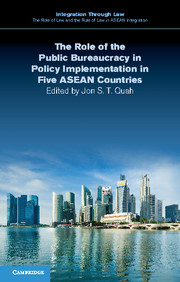Book contents
- Frontmatter
- Contents
- List of tables
- List of contributors
- General editors’ preface
- Preface
- 1 The role of the public bureaucracy in policy implementation in five ASEAN countries: a comparative overview
- 2 Weak central authority and fragmented bureaucracy: a study of policy implementation in Indonesia
- 3 The public bureaucracy's role in policy implementation in Malaysia
- 4 Dysfunctional bureaucracy, corruption and weak rule of law: a case study of policy implementation in the Philippines
- 5 Governance and meritocracy: a study of policy implementation in Singapore
- 6 Vietnam's public bureaucracy and implementation of two ASEAN policies
- 7 Policy implementation in ASEAN and the European Union: the problem of asymmetric compliance
- Executive summary
- Index
- References
4 - Dysfunctional bureaucracy, corruption and weak rule of law: a case study of policy implementation in the Philippines
Published online by Cambridge University Press: 05 February 2016
- Frontmatter
- Contents
- List of tables
- List of contributors
- General editors’ preface
- Preface
- 1 The role of the public bureaucracy in policy implementation in five ASEAN countries: a comparative overview
- 2 Weak central authority and fragmented bureaucracy: a study of policy implementation in Indonesia
- 3 The public bureaucracy's role in policy implementation in Malaysia
- 4 Dysfunctional bureaucracy, corruption and weak rule of law: a case study of policy implementation in the Philippines
- 5 Governance and meritocracy: a study of policy implementation in Singapore
- 6 Vietnam's public bureaucracy and implementation of two ASEAN policies
- 7 Policy implementation in ASEAN and the European Union: the problem of asymmetric compliance
- Executive summary
- Index
- References
Summary
Introduction
In 2013, the population of the Association of Southeast Asian Nations (ASEAN) was almost twice that of the United States, one-fifth more than that of the European Union (EU) and nearly five times that of Japan (Haub and Kaneda 2013). Alongside their giant neighbours India and China, the increasing size and influence of ASEAN makes it an attractive destination for investment (Hew and Soesastro 2003). Among the ten very diverse countries of the ASEAN, six nations have emerged with more mature economies: these are the ASEAN-6 comprising Indonesia, Malaysia, Singapore, Thailand, the Philippines and Brunei Darussalam. These six economies within the ASEAN have ‘grown rapidly’ and ‘become industrially competitive’ (Severino 2007: 411). The recent history of the region reveals that in terms of ‘economic and institutional development’ as well as ‘global and capital market integration’ the ASEAN-6 remain far ahead of Vietnam, Cambodia, Laos and Myanmar (Gates and Than 2001: 3).
However, one country within the famed ASEAN-6 has experienced an ambivalent performance as regards policy implementation – the Philippines. Heralded as a very promising nation in the 1960s and 1970s, the country has been often referred to as the ‘sick man of Asia’. Not only has it suffered from chronic deficits in the effective implementation of economic policies, it has also lagged behind most of its neighbours in implementing vital redistributive social policies. The Philippines ‘has the highest incidence of poverty measured by the proportion of population living below US$1 per day and the highest income inequality’ among the ASEAN-6 (Balboa, Medalla and Yap 2007: 2).
This chapter provides a case study of policy implementation in the Philippines. It describes how a dysfunctional public bureaucracy aggravated by weak rule of law within a context of systemic corruption hinders the implementation of policies. In undertaking an evaluation of policy implementation, this chapter evaluates two specific ASEAN-wide policies from a Philippine perspective: the ASEAN Cosmetic Directive (ACD) and the ASEAN Ministerial Meeting on Transnational Crime/Senior Officials Meeting on Transnational Crime (AMMTC/SOMTC). Recognizing the unique context of the Philippines, this chapter analyses the issues and challenges related to the implementation of these two policies.
Policy context
In order better to appreciate the issues and challenges that face the Philippines – particularly its civil service, an analysis of the policy context is needed.
- Type
- Chapter
- Information
- Publisher: Cambridge University PressPrint publication year: 2016
References
- 2
- Cited by

